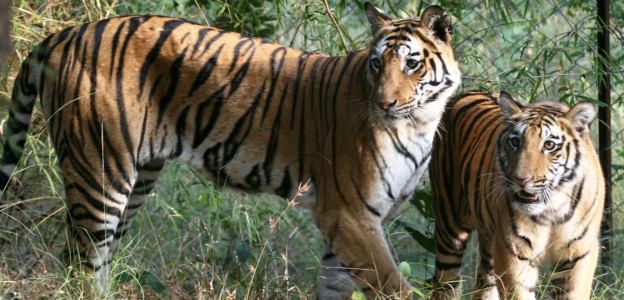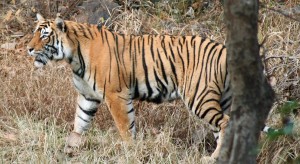Bamera ,beautiful male tiger of Bandhavgarh
13
AugIt was our first afternoon into the reserve and we had AC route. It was Thanksgiving Day for Americans. I was sure for some reason or some hope I was going to see Bamera male. It was pretty quiet, no alarm calls and other jeeps had come by without luck either. It was getting late and we stopped by Ghora Demon ,a famous area where a tiger has good cover and water inside a deep ravine. It was said that the pugmarks of a male were seen and so we waited at one end of the ravine. Another jeep drove by and we decided to have them wait at the top while we stayed at the bottom. One of the guides was positive a male tiger was in the ravine. We had agreed that whoever saw the tiger emerge out of the ravine would give out a whistle. It was no more than 2 minutes and we heard a loud whistle. The guys yelled “TIGER”. We turned around and quickly got up to the top and there off to the left of the track no further than 6 or 7 feet was beautiful Bamera . He was just lying down with his huge head resting on his left paw. We all started clicking away with our cameras, or whatever device we had on hand. He was so calm and then he raised his head up and kept looking at us with his mesmerizing golden eyes. I also had binoculars so when I zoomed out I looked at him closely and saw a droplet of water dripping from his nose where he had gotten a gash from a fight with his father B2. I literally wanted to get out of the jeep and go sit next to him.
He looked so peaceful, I am sure he just wanted to rest a little before going on his way to hunt during the night. We were going to be late leaving the park and reaching the main gate so we had to drive a little fast but we made it. I am so excited of how close I was to seeing him. I am truly blessed. I wish for everyone to witness that. I will never forget my beautiful Bamera. As we were leaving him I waved goodbye to him and said “Bye Bamera”. I know I will see him again.
READ MORE

Big Five of The Indian Wildlife
07
JulWildlife in India has been more known for because of popular national parks of North and Central India like- Kanha, Bandhavgarh, Pench, Ranthambore and Corbett. In between these parks one can see the Big Five of The Indian Wildlife from North and Central India, namely, The Asiatic Elephant, The Gaur, The Leopard, The Royal Bengal Tiger The Sloth Bear. We, however, decided to provide a unique experience to our clients with a pioneer trip to North East India to see the other aspect of Indian Wildlife with emphasis on seeing the Big Five of North East India.
READ MORE
Welcome to Indian Wildlife Expeditions
07
JulOn this planet, if any region exists in terms of unmatched variety of Flora and Fauna- It is India’.
No region can compete with India in terms of its culture, climate, vegetation and wildlife. With a civilization more than 5,000 years old, with every ethnic group known to mankind, with five seasons every year, with a festival every day, with incredible variety of terrain including beaches on its 7516.5 km coastline, with its 89 National Parks and 489 Wildlife Sanctuaries, 19 Ramsar Sites and 13 Biosphere Reserves, India is indeed a wonderland.
Few know about its diversity of its habitat and its wildlife as we do at Indian Nature Tours. The Lions, the tigers, three types of Leopards along with nine other species of cats make India a Tiger Country.
It also has the largest dear population (species) in the world and unlike Africa, India also has antelopes.
Some of the species found in India are “Indigenous and are found nowhere in the world” i.e. Sloth Bear, Blackbuck (Indian Antelope), Chausingha (Four horned antelope), and Nilgai (Blue Bull).
With over 1250 species of birds, India is also a paradise for bird lovers.
In addition to its birds & animals, India also boasts of over 20,000 species of insects, 2,000 species of butterfly, 142 species of frogs and over 700 species of fish.
READ MORE
Exploring Gardens of India
07
JulIndia by virtue of its varied topography, climate and, Special Interest Tours habitats is very rich in biodiversity resources starting from cold desert to the tropical littoral forests. It is also rich in its folk and traditional knowledge of properties and uses of these resources. Biodiversity resources are valued directly such as food for human, fodder for animals, energy source as fuel, nutrients like leaf manure and structural materials like pharmaceuticals, fibre, fragrances, flavours, dyes and other materials of special interest.
In India, the diversity of plant species, within the species and habitats are very remarkable. A record of India’s plant wealth indicates that there are approximately 17500 species of angiosperms, 48 species of gymnosperms, 1200 species of ferns, 6500 species of algae, 14500 species of fungi, 2500 species of lichens, 845 species of liverworts and 1980 species of mosses
India has 47,000 species of the flowering and non-flowering plants representing about 12 % of the recorded world’s flora. Out of 47,000 species of plants, 5150 are endemic and 2,532 species are found in the Himalayas and the adjoining regions and 1,782 in the peninsular India. Areas rich in endemism are north-eastern India, the southern parts of peninsular India, the Western Ghats and the north-western and eastern Himalaya.
India is one of the twelve megadiversity countries in the world with a ranking of tenth in the world and fourth in Asia in plant diversity. Among the 18 hot spots in the world, two are found in India i.e. The Western Ghats and the Eastern Himalayas. Together they have a very high percentage of endemic species of both flora and fauna.
Through the sketch itineraries mentioned herewith we have tried to provide in depth exposure to people interested in flora and fauna of India.
READ MORE
Darjeeling and The Tea
07
JulThe story of the Tea in Colonial India and that of Darjeeling started some 150 years ago when Dr. Campbell, a civil surgeon, planted tea seeds in his garden at Beechwood, Darjeeling, 7000 ft above sea level as an experiment. He was reasonably successful in raising
the plant because the government, in 1847, elected to put out tea nurseries in this area.
According to records, the first commercial tea gardens planted out by the British tea interests were Tukvar, Steinthal and Aloobari tea estates. This was in 1852 and all these plantations used seeds that were raised in the government nurseries.
Darjeeling Tea has come a long way since then and is now appreciated worldwide as hallmark of authenticity, purity and quality. It is not just a tea- A philosophy, tradition, knowledge and way of life- practiced and followed by generations through the ages.
Today there are 86 running gardens producing ‘Darjeeling Tea’ on a total area of 19,000 hectares. The total production rages from 10 to 11 million kgs annually.
Indian Nature Tours arranges special Tea Tours including overnight halts at the extravagant British heritage Tea Bungalows of Glenburn ,Goomti , Makaibari and Phaskowa tea estates.
Makaibari
Cradled in the lap of the Himalayas, the mystical land of the ancient seers and saints, where the Vedas were created, Makaibari (literally “Maize Land”) is in Kurseong, the Land of the White Orchid, in Darjeeling. In 1859, this magical land saw the development of the now fabled tea estate. It went on to become the best tea garden in the world. But not just that….
Tropical rainforests and temperate forests merge in a short span of 35 kms from Siliguri to Kurseong and onward, another 35 km to Darjeeling. Within the boundaries of Makaibari, the diversity of flora and fauna is astounding. Enter Chungey, the dream plot of Makaibari, and the chirping birds, rustling leaves, rumblings of a distant waterfall greet you.
There is a dense forest in Makaibari whose secrets have been scouted by few. There is a huge piece of fossil with the impression of an elephant’s foot imprinted. How many thousand years old it is no one knows. Over the four generations, barring the current one, attempts have been made to lift the stone, but none has been able to do so. Rajah Banerjee, of course, would not dream of doing anything to disturb nature. So it is there for people to see.
Snakes, monkeys, rabbits, leopards, Himalayan goats and pheasants, seven natural springs of Himalayan mineral water which originate in Makaibari and give it all the water it consumes….it is an ecotourist’s dream. In some places the incline of the land is close to 80 degrees and Rajah Banerjee had taken up the challenge of growing and plucking tea from there. The Makaibari community has done it! Try scaling those inclines, and see the scars of landslides, the flesh of the forest ripped out due to deforestation, on the opposite sides of Makaibari in lands belonging to other gardens. You’ll feel the difference.
Glenburn
…a world of fine traditions…….
Started by a Scottish tea company in 1860, Glenburn has now passed into the hands of one of India’s pioneering tea planting families The Prakashes, who have over the years come to be known as the “Chaiwala family” which literally means “tea planters”.
The story of the Chaiwala family began over a hundred years ago, and is closely
entwined with that of tea
plantations in India. Today, the third and fourth generation Prakash family,
carry almost a century of tea knowledge in their inheritance, and invite you
to visit Glenburn.
….and spectacular scenery…..
Glenburn a name that literally describes what this 1,600 acre estate is a river valley. With breathtaking views of the Kanchenjunga Mountain Range, Glenburn stretches from an elevation of 3,700 feet, all the way down to the sandy banks of the two snow-fed Himalayan rivers that meander through it The Rungeet and The Rung Dung.
Apart from the sprawling tea fields, Glenburn have forests which are a bird watcher and hiker’s paradise. Across the river lie the forests and villages of the old royal kingdom of Sikkim, which you can access via a hanging bridge.
READ MORE
ORCHID TOUR OF INDIA
07
JulThis tour is meant for individual orchid lovers having serious interest in orchids
as well as for the orchid societies. This tour can provide exposure to their
members of some rare varieties of orchids found in this bio-diversity rich "hot
spot of India
READ MORE





